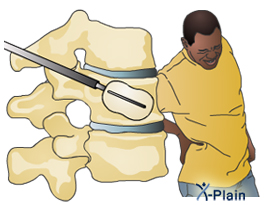What Is Kyphoplasty Balloon ?
Kyphoplasty
Kyphoplasty is used to treat painful compression fractures in the spine. In a compression fracture, all or part of a spine bone collapses.The procedure is also called balloon kyphoplasty.
Description
Kyphoplasty is done in a hospital or outpatient clinic.
You may have local anesthesia (awake and unable to feel pain). You will likely also receive medicine to help you relax and feel sleepy.
You may receive general anesthesia. You will be asleep and unable to feel pain.
You lie face down on a table. The health care provider cleans the area of your back and applies medicine to numb the area.
The doctor places a needle through the skin and into the spine bone. Real-time x-ray images are used to guide the doctor to the correct area in your lower back.
A balloon is placed through the needle, into the bone, and then inflated. This restores the height of the vertebrae. Cement is then injected into the space to make sure it does not collapse again.
Why the Procedure is Performed
A common cause of compression fractures of the spine is thinning of your bones, or osteoporosis. Your doctor may recommend this procedure if you have severe and disabling pain for 2 months or more that does not get better with bed rest, pain medicines, and physical therapy.
Your doctor may also recommend this procedure if you have a painful compression fractures of the spine due to
Cancer, including multiple myeloma
Injury that caused broken bones in the spine
Risks
Kyphoplasty is generally safe. Complications may include:
Bleeding
Infection
Allergic reactions to medicines
Breathing or heart problems if you have general anesthesia
Leakage of the bone cement into surrounding area (this can cause pain if it affects the spine or nerves). Leakage can lead to other treatments to remove the cement.
Before the Procedure
Before surgery, always tell your doctor or nurse:
If you could be pregnant
What drugs you are taking, even those you buy without a prescription
If you have been drinking a lot of alcohol
During the days before the surgery:
You may be asked to stop taking aspirin, ibuprofen, coumadin (warfarin), and other drugs that make it hard for your blood to clot.
Ask your doctor which drugs you should still take on the day of the surgery.
If you smoke, tried to stop
On the day of the surgery:
You will usually be told not to drink or eat anything for several hours before the test.
Take your drugs your doctor told you to take with a small sip of water.
Your doctor or nurse will tell you when to arrive.
After the Procedure
You will probably go home on the same day of surgery. You should not drive, unless your doctor says it is OK.
After the procedure:
You should be able to walk. However, it is best to stay in bed for the first 24 hours, except to use the bathroom.
After 24 hours, slowly return to your regular activities.
Avoid heavy lifting and strenuous activities for at least 6 weeks.
Apply ice to the wound area if you have pain where the needle was inserted.
Outlook (Prognosis)
People who have kyphoplasty often have less pain and a better quality of life after the surgery. They often need fewer pain medicines, and can move better than before.
Alternative Names
Balloon kyphoplasty Balloon kyphoplasty
References
Wardlaw D, Cummings SR, Van Meirhaeghe J, et al. Efficacy and safety of balloon kyphoplasty compared with non-surgical care for vertebral compression fracture (FREE): a randomised controlled trial.Wardlaw D, Cummings SR, Van Meirhaeghe J, et al. Efficacy and safety of balloon kyphoplasty compared with non-surgical care for vertebral compression fracture (FREE): a randomised controlled trial. Lancet. 2009;373(9668):1016-24.
Berenson J, Pflugmacher R, Jarzem P, et al.; Cancer Patient Fracture Evaluation (CAFE) Investigators. Balloon kyphoplasty versus non-surgical fracture management for treatment of painful vertebral body compression fractures in patients with cancer: a multicentre, randomised controlled trial.Berenson J, Pflugmacher R, Jarzem P, et al.; Cancer Patient Fracture Evaluation (CAFE) Investigators. Balloon kyphoplasty versus non-surgical fracture management for treatment of painful vertebral body compression fractures in patients with cancer: a multicentre, randomised controlled trial. Lancet Oncol. 2011 Mar;12(3):225-35.
Anselmetti GC, Muto M, Guglielmi G, et al. Percutaneous vertebroplasty or kyphoplasty. Radiol Clin North Am
Update Date 10/14/2013
Updated by: C. Benjamin Ma, MD, Assistant Professor, Chief, Sports Medicine and Shoulder Service, UCSF Department of Orthopaedic Surgery. Also reviewed by David Zieve, MD, MHA, Bethanne Black, and the A.D.A.M. Editorial team.
Browse the Encyclopedia